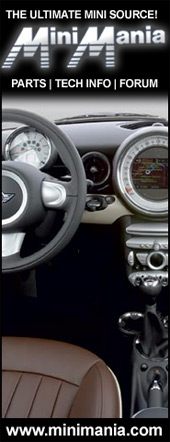
| The use of notched rubber power transmission belts to operate cyclic or timed mechanisms is not unique, naturally, being in constant industrial usage, but this marks the first successful automotive application to our knowledge. Advantages of the 1.5 inch wide belt of molded rubber, bonded to a continuous steel wire base, over the more conventional chain or gears, are many. Lighter in weight, therefore lower in inertia, far more likely to disintegrate slowly than to snap suddenly, and needing no lubrication nor housing, the U.S. Rubber product certainly gets the nod .. if it doesn't stretch. |
| Such belts have been tried on super-chargers to replace V belts, which suffer from considerable slippage, but sheared pulley keys and pins soon proved that their action is too positive. In this cam driving application the belt has proven admirably suited, although many prophesied that under severe acceleration there would be enough resiliency or backlash to foul up valve timing. But, no stretch! |
| A machine adaptation for the front of the cam housing on the Norton head, with its hairpin springs, eliminated the tower shaft and several gears. As she sits, a notched pulley with 28 teeth on the end of each camshaft is driven through its own belt by a 14-tooth pulley on the front end of the main shaft .. a spot formerly occupied by the generator pulley, Two idlers maintain tension. Grafting the Norton cylinders onto the Panhard case required filling the original stud holes with 1/4-inch aluminum bolts and drilling new holes to accommodate the 7/16-inch Norton studs.There is no difference in displacement as a result of the switch, inasmuch as the bore diameter of both makes is the same: 3.12 inches. The Panhard stroke of 2.94 inches produces an oversquare engine. Although the Norton barrels are somewhat larger in overall size due to the greater fin area, there is no appreciable gain in weight, inasmuch as the Panhard is cast-iron-sleeved and the Norton all lightweight alloy. |
| Superimposed over the stock but overstressed bottom end, we find a big-ported head, straight-through porting, monster valves... 1-27/32 inch intake and 1.75 inch exhaust. A compression ratio of 9.5 to 1, effected through the use of Norton hi-dome pistons, is about the maximum desirable for gasoline fed replacement Weber carbs on Y inlet manifolds... one for each cylinder. The flywheel has been lightened through replace-mentl Not to overlook details, Devin whittled out a duplicate in aluminum and pressed on the steel starter ring gear... saved 8 pounds and gained much acceleration. |
| What actual timing he will run on a different "New" engine, Devin keeps to himself. Data on the improved model is also confidential but, as one who has been permitted to view some of the actual construction, we can say that the latest crossbreed will employ FOUR overhead cams, twin ignition and fuel injection. |

1 comment:
why is some of the right side of the text cut off in the Devin-H-Mod Special post?
Post a Comment